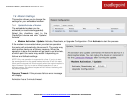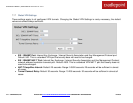
CRADLEPOINT IBR650 | USER MANUAL Firmware ver. 3.3.0
© 2011 CRADLEPOINT, INC. PLEASE VISIT HTTP://KNOWLEDGEBASE.CRADLEPOINT.COM/ FOR MORE HELP AND RESOURCES PAGE 88
7.7.1 Page 1: General
Tunnel Name: Choose a name meaningful to you.
Local Identity: This can be left blank for most users. If left blank
it will default to the IP address of the WAN connection. Currently
we only support identifiers in the form of an IP address, a user
fully qualified domain name (user@mydomain.com) or just a
fully qualified domain name (www.mydomain.com). If the
remote side of the tunnel is configured to expect an identifier,
then both must match in order for the negotiation to succeed.
Remote Identity: This can be left blank for most users. If left
blank it will default to the IP address of the WAN connection.
Currently we only support identifiers in the form of an IP
address, a user fully qualified domain name
(user@mydomain.com) or just a fully qualified domain name
(www.mydomain.com). If no identifier is defined then no
verification of the remote peer's identification will be done.
Pre-shared Key: Create a password or key. The routers on both
sides of the tunnel must use this same key.
Mode: Tunnel or Transport. Tunnel Mode is used for
protecting traffic between different networks, when traffic must
pass through an intermediate, untrusted network. Transport
Mode is used for end-to-end communications (for example, for
communications between a client and a server).
Initiator Mode: ―Always On/Boot” or ―On Demand.‖ ―Always On/Boot‖ is used if you want the tunnel to initiate the
tunnel connection whenever the WAN becomes available. On Demand is used if you want the tunnel to initiate a
connection if and only if there is data traffic bound for the remote side of the tunnel.


















